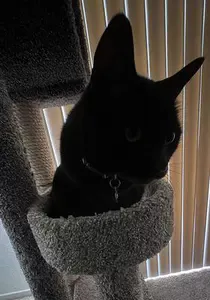What is Cat Ringworm? (And What to Do About It)
Cat ringworm is actually not a worm, but a contagious fungal infection. The symptoms are easy to spot, but stubborn cases can be difficult to cure. Successful treatment often takes weeks or months before your cat is free of the disease.
What is Cat Ringworm?
Cat ringworm is the most common infectious skin disease in felines.
Ringworm (known as dermatophytosis) is a fungus which lives on keratin (a protein found in skin, hair and nails).
There are three species of ringworm that commonly infect felines:
- Microsporum canis (most common)
- Trichophyton mentagrophytes (usually contracted through contact with rodents)
- Microsporum gypseum/fulvum (usually contracted from contact with spores in the soil)
Generally, ringworm most often affects two different classes of cat:
- Kittens, whose immune systems have not fully developed
- Adult felines who have been immunocompromised (have a weakened immune system)
A cat's immune system can often be weakened by stress, drugs, or other diseases, conditions, or disorders.
Ringworm Transmission
How is cat ringworm transmitted?
Ringworm is spread by contact with fungal spores (called arthrospores). Contact can occur in the following ways:
- Contact with an infected animal.
- A carrier animal that shows no symptoms.
- Direct contact with the actual fungal spores in the environment (such as in soil).
Like all spores, they are very resistant to environmental factors, and can live for up to 18 months.
Not all pets in a household or kennel that are exposed to the fungus develop the disease. Some may become infected but develop no obvious signs of the disease. Some of these animals will become carriers.
Contaminated grooming supplies and electric hair clippers can also transmit the disease.
In an infected animal, sheaths of arthrospores can be found around the infected areas (on hair strands, skin, or nails). These spores are shed, and then travel.
Spores can commonly be found in:
- Carpeting
- Furniture
- Cat bedding
- Air filters
Ringworm is also the most common zoonotic disease, meaning that it can be passed from animals to humans. According to the Centers for Disease Control, cats, dogs, cows, goats, pigs, and horses can all pass ringworm to humans. It should be noted that M. canis can be transmitted to humans, but not all forms of the disease can.
If your cat has ringworm you should take steps to prevent contracting it yourself. Use gloves and wear an apron when handling your cat, and wash your clothes right after contact with your cat.
Cats can also be asymptomatic carriers. If you have multiple pets, and one pet has ringworm but the others seem symptom free, it is possible that one of them is a carrier. You'll need your vet to help you sort that one out.
Cat Ringworm Symptom List
So, you think your cat has ringworm. How do you know?
The classic ringworm symptom in cats presents as patches of hair loss which look like circular scaly areas with raised edges. After all, this disease gets its name from the round ring-like appearance on the skin.
The symptoms your cat may show can be very variable. Some cats infected with ringworm show little or no hair loss at all, and seem relatively unbothered by it. Others can have marked hair loss with pronounced scaly lesions which can extend to the entire body.
The infected patches of skin heal centrally as the ringworm works its way outward from the initial point of contact on the cat's body.
The circular area expands as the skin heals in the center, and the fungus moves beyond the edge of the ring (the innermost area of the lesion is already healing, while the outermost raised area is the area where the ringworm is the most active).
Look for the following:
- Loss of hair in circular patterns
- Broken hair in circular patterns
- Hair loss in irregular patterns
- Scaly or bumpy skin
- Red and inflamed skin
- Itchiness (occasionally)
- Deformed claws
The most common locations for infection are:
- The head
- Face
- Ears
- Tail
- Paws
Early symptoms include:
- Dry, flaky skin
- Bald areas on ears, the legs, and around the eyes.
Affected areas may be itchy or not.
Feline ringworm is a self-limiting disease, meaning that it can clear up by itself. If that is the case, symptoms should not last more than six to eight weeks.
In some cats, especially those who are immunosuppressed, the symptoms may persist.
If left untreated, symptoms will continue to worsen and eventually develop into crusty, infected lesions that often become red and sore.
If this is the case, then feline ringworm needs to be treated with medication. This is the preferred option by most veterinarians in any case, since the disease can be passed to other animals and humans.
Ringworm Diagnosis
Obviously, a diagnosis of ringworm starts with noticing the visible signs and symptoms. If you suspect that your cat has ringworm, or any other health issue, please take your cat to your veterinarian for proper diagnosis and treatment.
Your vet may use an ultraviolet lamp (Wood's Lamp) test, in which a bit of infected hairs/skin/nails is placed under the lamp. Areas infected with M. canis will 'glow' (only M. canis glows under the lamp).
Microscopic examination of hair and skin is also used for confirmation, but this depends upon the technical skill of the examiner.
The most reliable test for ringworm is to take a skin scraping and perform a fungal culture on it. This is usually done by sending the sample to a diagnostic laboratory, but some vets will grow cultures in-house.
Treatment of Ringworm in Cats
Ringworm is often what's known as a self-limiting disease. In other words, in many cases it will clear up on its own, but this can take several months. Not all cats are able to fight off the disease, and there is a possibility that genetic predisposition may be involved.
Some sources say that all animals, unless they are immunosuppressed, will eventually become immune to ringworm.
Medication can be given to assist in the healing process, and help stop the spread of the fungus. Those medications can be in the form:
- Oral or topical antifungal treatments
- Medicated dips
- Sprays
- Shampoos
Oral medications have been found to work best at treating and stopping the spread of ringworm in cats. There can be side effects from these, so you'll have to work closely with your veterinarian on this.
You may have heard about a vaccine for cat ringworm. It does exist, but it only treats the clinical signs of the disease, not the actual fungal infection!
Following an episode of ringworm in your cat, you'll want to ensure that your cat is fungus free. Have your cat retested by your vet.
It is recommended that all infected cats, especially long haired cats, be clipped. This allows topical agents to work better, and also prevents broken hairs from spreading the spores, causing reinfection.
Part of the treatment plan is to prevent reinfection, or infection of other pets and family members. In order to do this, you'll have to try to get rid of the spores.
This includes vacuuming at least weekly (preferably daily). If you have a bag vacuum, dispose of the bag each time you use it. It also includes treating all surfaces possible with a cleaning agent.
The recommendation is to use a bleach and water solution in a 1 to 10 ratio. For fabric and surfaces that won't stand 1 to 10, a 1 to 30 solution can be used with repeated cleanings.
Obviously, be careful with this and don't let your children, cat, or other pets get into the wet bleach. And, test all materials for colorfastness.
Related Topics
Cat Ringworm
For some pictures of what the symptoms of ringworm look like, take a look at International Cat Care
Cat Health
Cat Illness Symptoms
Cat Lovers Only


Comments: What do you think?
Have your say about what you just read. Leave me a comment in the box below.